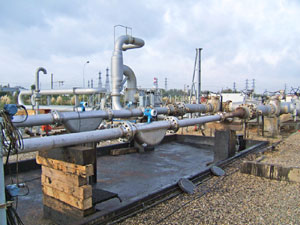 Technology from Europe: Technology from Europe:
United Kingdom
Accuracy tested with Coriolis meter
In times of high crude oil prices, even small improvements in measured accuracy represent large amounts of money. New technologies allow for higher accuracies and lower maintenance for petroleum and natural gas flow measurement and, therefore, better monitoring of consumption and usage.
Coriolis mass flowmeters operate on the inertial forces that are generated whenever a particle, flowing in a curved tube about a center, moves in a direction towards, or away from, the center of rotation. Endress+Hauser Promass flowmeters are used to measure crude and refined petroleum products, liquefied gas and gas.
 |
This test setup shows a 6-in. and 10-in. Coriolis mass flowmeter along with the 24-in. unidirectional ball prover being proven against a volumetric standard.
|
|
During October and November 2004, The company’s Promass F type Coriolis mass flowmeters were calibrated with oil at the Société du Pipeline Sud Européen (SPSE), Fos sur Mer, France. Proving considerations followed the procedures according to API Chapter 5, Section 6, in order to obtain custody transfer approval according to OIML recommendations R117, Class 0.3.
The proving calculations were witnessed by the Nederlands Meetinstituut (NMi) and conducted on four oils: naphtha, Oural crude, condensate and fuel oil with different densities and viscosities. Covering the entire density and viscosity range, the results obtained showed accuracies and repeatability over three (OIML) or five (API) consecutive runs of the prover. With linear behavior over the entire range, the Coriolis flowmeter sets new standards for fiscal and custody transfer measurement in the oil and gas and petrochemical industries.
In December 2005, additional tests showed results using a 24-in. unidirectional ball prover of 15,000-l capacity. A dozen 10-in. Promass Coriolis mass flowmeters were calibrated against the prover with four different oils, ranging in density from 690 kg/m3 to 960 kg/m3 and viscosities from 0.7 cSt to 180 cSt. It was the world premiere for bi-directional and tandem calibrations.
The bi-directional calibration involved forward and reverse flowrates through the meter without changing the piping. NMi approvals now include bi-directional use of the Promass Coriolis meter for custody transfer. Two 10-in. Promass meters were operated in parallel with two Y-joints for the tandem calibration. Over a flowrate stretching from the minimum prover flowrate, 200 ton/hr (36,000 bopd), to 2,200 ton/hr (400,000 bopd) of Oural crude, the common meter factor was well below 0.0004 limit, or 0.04%.
With these results, this meter combines the accuracy of a positive-displacement meter with the repeatability of a turbine. It has no moving parts and a broader operational window compared to an ultrasonic flowmeter. The Coriolis meter is independent of viscosity changes and does not require regular validation. 
|

 Technology from Europe:
Technology from Europe:

